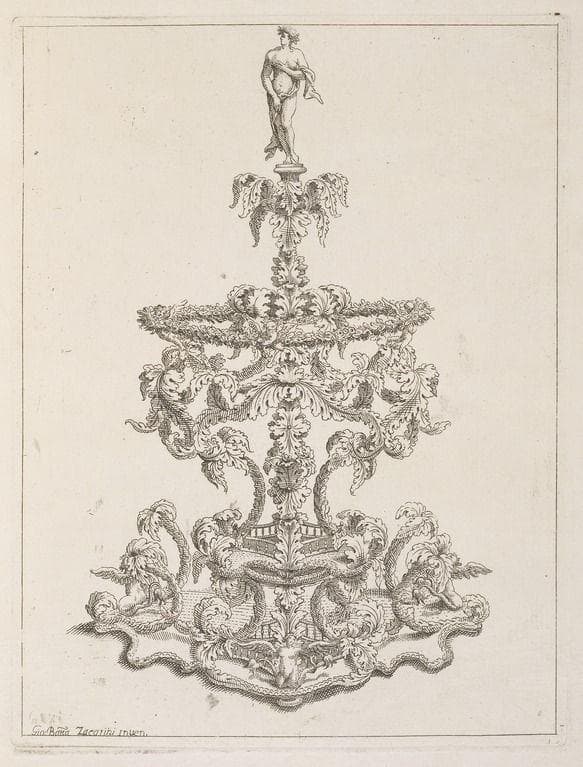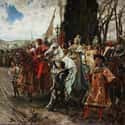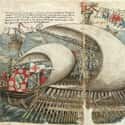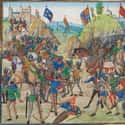-
(#7) MYTH: Knights Were The Dominant Force Throughout The Middle Ages
The Reality: While various forms of heavy cavalry were indispensable in most medieval engagements, there was another innovation that changed medieval conflict: the longbow. Primarily known as the English weapon of choice during the Hundred Years' War, the longbow was used for a variety of tactical purposes. For example, a large group of longbowmen could be used to prevent the enemy from spreading out and flanking a cavalry charge.
Why the Myth: The longbow is sometimes mentioned in connection with the Battle of Agincourt (although its role there has been disputed), but its importance throughout the Hundred Years' War - in battles like Sluys, Crecy, and Poitiers - is rarely appreciated. While it did not replace the cavalry charge as an important maneuver, it completely rewrote history, giving England a string of victories and reshaping the political maps of Europe for generations.
-
(#3) MYTH: Full-Body Armor Was Reserved For The Wealthy
The Reality: Heavy cavalry such as knights were a key component of any medieval fighting force; however, no rules prohibited foot soldiers from wearing armor. Indeed, troops were responsible for acquiring their own armor, so any man with the means likely had at least a helmet or a chainmail shirt. Wealthier warriors - such as men of the new and rising middle class - could outfit themselves however they liked, although a full suit of armor would have been difficult to maintain for an infantryman.
Why the Myth: In part, this myth originates from Hollywood. However, the original notion is also based on misconceptions about class in the medieval world. A commonly held myth is that people were either lords, knights, or peasants. All infantrymen were thought to be peasants who couldn't afford armor, which gave rise to the myth.
-
(#2) MYTH: There Was No Mercy
The Reality: Mercy in armed engagements during the Middle Ages was largely subject to the character of the victorious leader. However, many recorded incidences of merciful conduct, particularly between Christian forces, exist from the time. Orderic Vitalis, a chronicler and monk, wrote of an engagement between the English and the French:
They were all clad in mail and spared each other on both sides, out of fear of God and fellowship in arms... they were more concerned to capture than [vanquish] the fugitives. As Christian [men], they did not thirst for the blood of their brothers, but rejoiced in a just victory given by God for the good of Holy Church and the peace of the faithful.
Why the Myth: This is another example of sensationalism in historical writing. The most gripping moments in medieval conflicts tend to be the most brutal, and so bloody fights like the Crusader attack on Jerusalem or the Battle of Hastings are remembered most prominently. However, that doesn't mean that vicious, merciless battles were commonplace. Most battles were smaller and low-stakes, which made mercy more probable.
-
(#14) MYTH: All Battles Were Fought On Land
The Reality: The lack of technological progress in the Middle Ages meant that most maritime skirmishes were fought in the same manner as those in the Roman era. Ships would use projectiles to pick off sailors before grappling and boarding the ship and engaging in hand-to-hand combat. This method of engagement also kept many ships intact, to be taken by the winning side.
Why the Myth: Because ships were difficult to sink, few large-scale maritime fights occurred during this era. Most conflicts revolved around securing waterways to transport troops. This was especially true in the case of the Crusades, where piracy became a serious issue for the Crusaders as they attempted to travel by sea to the Middle East. However, this rarity makes these conflicts difficult to contextualize for historians, since maritime skirmishes were almost always ancillary to larger ground conflicts.
-
(#13) MYTH: Medieval Troops Were Heavily Armed And Armored
The Reality: As with conflict throughout the ages, different forces in the Middle Ages conducted battle differently. The large, unwieldy forces of the major powers might well have been heavily armed. For example, when the English fought the French, they were dealing with a fairly conventional type of conflict. However, when their heavily armed and armored troops took on the Welsh, they were faced with a band of guerilla fighters who raided their supply lines and picked off small groups.
Why the Myth: Simply because there were so many skirmishes during this period, history books tend to focus on massive campaigns between great powers. Decades-long conflicts are often boiled down to one big, decisive engagement. While this perception may help simplify the events of the Middle Ages to a digestible level, it is largely inaccurate.
-
(#8) MYTH: All Combatants Belonged To A Nation Or State
The Reality: Mercenaries were plentiful in the medieval world, although they are most closely associated with the small city-states of 13th-century Italy. These states didn't possess the manpower to field troops of their own, but they were wealthy enough to pay for powerful hired companies. These professional troops, comprised of men from all over Europe - former warriors, deserters, lifelong sellswords, and the like - had to travel to wherever the conflict was taking place. They played a significant role in the Hundred Years' War between England and France.
Why the Myth: This myth can be traced back to the way medieval history was taught during nationalist periods in Europe. Historians, in examining the large-scale motions of history, tend to emphasize nations and countries, because that is how we view the world today. However, medieval Europe can be better understood as a series of fiefdoms of various sizes. Many nations, like Italy and Germany, did not exist as we understand them today.
New Random Displays Display All By Ranking
About This Tool
Our data comes from Ranker, If you want to participate in the ranking of items displayed on this page, please click here.
















